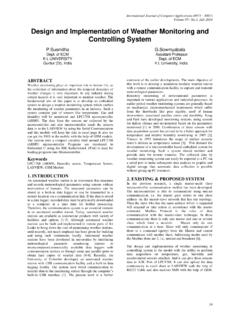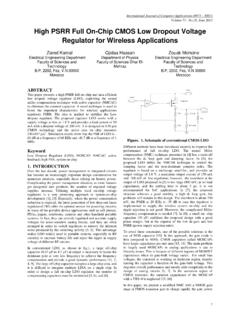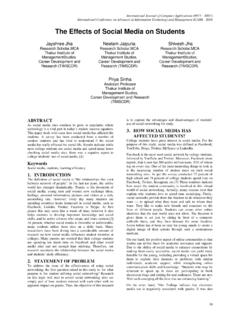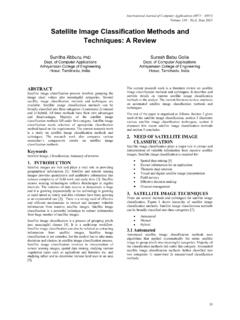Transcription of Smart Home Automation: A Literature Review
1 International Journal of Computer Applications (0975 8887) National Seminar on Recent Trends in Data Mining (RTDM 2016) 6 Smart home automation : A Literature Review Vaishnavi S. Gunge Walchand Institute of Technology Solapur Pratibha S. Yalagi Walchand Institute of Technology Solapur ABSTRACT home automation is becoming popular due to its numerous benefits. home automation refers to the control of home appliances and domestic features by local networking or by remote control . Artificial Intelligence provides us the framework to go real-time decision and automation for Internet of Things (IoT).The work deals with discussion about different intelligent home automation systems and technologies from a various features standpoint. The work focuses on concept of home automation where the monitoring and control operations are facilitating through Smart devices installed in residential buildings.
2 Heterogeneous home - automation systems and technologies considered in Review with central controller based (Arduino or Raspberry pi), web based, email based, Bluetooth-based, mobile-based, SMS based, ZigBee based, Dual Tone Multi Frequency-based, cloud-based and the Internet with performance. Keywords home - automation , Intelligence, Microcontroller, Sensor system , User-friendly Interface 1. INTRODUCTION automation is a technique, method, or system of operating or controlling a process by electronic devices with reducing human involvement to a minimum. The fundamental of building an automation system for an office or home is increasing day-by-day with numerous benefits. Industrialist and researchers are working to build efficient and affordability automatic systems to monitor and control different machines like lights, fans, AC based on the requirement.
3 automation makes not only an efficient but also an economical use of the electricity and water and reduces much of the wastage [5]. IoT grant to people and things to be connected Any-time, anyplace, with anyone, ideally using any network and any service [10]. automation is another important application of IoT technologies. It is the monitoring of the energy consumption and the Controlling the environment in buildings, schools, offices and museums by using different types of sensors and actuators that control lights, temperature, and humidity. 2. home automation The Smart home known as House automation , with the use of new technology, to make the domestic activities more convenient, comfortable, secure and economical. The home automation system includes main components which are: User interface: as a monitor, computer, or Phone, for example, that can give orders to control system .
4 Mode of transmission: wired connections (example Ethernet) or Wireless (radio waves, infrared, Bluetooth, GSM) etc. Central Controller: It is hardware interface that communicates with user interface by controlling domestic services Electronic devices, a lamp, an AC or a heater, which is compatible with the transmission mode, and connected to the Central control system . The Figure 1 shows projected trends in the Smart home market in the coming year [10]. Figure 1: Popularity of Smart home in market Features of home automation system In recent years, wireless systems like Remote control have become more popular in home networking. Also in automation systems, the use of wireless technologies provide several advantages that could not be achieved with the use of a wired network only. Reduced Installation costs Installation costs are significantly reduced since no cabling is necessary.
5 Internet Connectivity control devices from anywhere in the world with use mobile phones to control Smart home . Scalable and Expandable With the Compare of Wireless network is especially useful when, due to New or changed requirements, an extension of the network is necessary. Security Easily add devices to create an integrated Smart home security system and built-in security ensures integrity of Smart home . Challenges of home automation system The work of John J. Greichen [12] discussed some of the early challenges faced by home automation systems. These include high manufacturing costs, high development costs, high installation costs, additional service and support costs, lack of home automation standards, consumer unfamiliarity with International Journal of Computer Applications (0975 8887) National Seminar on Recent Trends in Data Mining (RTDM 2016) 7 technology, and complex user interfaces.
6 With the advancement of time, rapid development in technology and processing power which leads to a considerable reduction in device cost and size. All of these factors have contributed to the popularity of electronic devices today, so people are no longer confused or unsure about the use of the computer, mobiles, or tablets. Moreover, a lot of home automation protocols, communication and interface standards. 3. Literature Review In this section, discussed different home automation system with their technology with features, benefit and limitations they have. The Figure 2 shows Basic Architecture of Remote home automation . Figure 2: Basic Block Diagram of home automation The home automation system that uses Wi-Fi technology [1]. system consists of three main components; web server, which presents system core that controls, and monitors users home and hardware interface module(Arduino PCB (ready-made), Wi-Fi shield PCB, 3 input alarms PCB, and 3 output actuators PCB.)
7 , which provides appropriate interface to sensors and actuator of home automation system . The system is better from the scalability and flexibility point of view than the commercially available home automation systems. The User may use the same technology to login to the server web based application..If server is connected to the internet, so remote users can access server web based application through the internet using compatible web browser. The application has been developed based on the android system [2]. An interface card has been developed to assure communication between the remote user, server, raspberry pi card and the home Appliances. The application has been installed on an android Smartphone, a web server, and a raspberry pi card to control the shutter of windows.
8 Android application on a smartphone issue command to raspberry pi card. An interface card has been realized to update signals between the actuator sensors and the raspberry pi card. Cloud-based home appliance monitoring and controlling system . Design and implement a home gateway to collect metadata from home appliances and send to the cloud-based data server to store on HDFS (Hadoop Distributed File system ), process them using MapReduce and use to provide a monitoring function to Remote user [3]. It has been implemented with Raspberry Pi through reading the subject of E-mail and the algorithm. Raspberry Pi proves to be a powerful, economic and efficient platform for implementing the Smart home automation [4].Raspberry pi based home automation is better than other home automation methods is several ways.
9 For example, in home automation through DTMF (dual tone multi-frequency) [11], the call tariff is a huge disadvantage, which is not the case in their proposed method. Also, in Web server based home automation , the design of web server and the memory space required is ejected by this method, because it simply uses the already existing web server service provided by G-mail. LEDs were used to indicate the switching action. system is interactive, efficient and flexible. Shih-Pang Tseng et al. [5] proposed Smart House Monitor & Manager (SHMM), based on the ZigBee, all sensors and actuators are connected by a ZigBee wireless network. They designed a simple Smart socket, which can remote control via ZigBee. PC host is used as a data collector and the motion sensing, all sensing data are transferred to the VM in the cloud.
10 The user can use the PC or Android phone to monitor or control through the Internet to power-saving of the house. Arduino microcontroller to receive user commands to execute through an Ethernet shield. Our house network used together both wireless ZigBee and wired X10 technologies [6]. This system followed Smart task scheduling with a heuristic for the Resource-constrained-scheduling problem (RCPSP). The mobile device can be either wired to the central controller through USB cable or communicates with it wirelessly, within the scope of the home . Arduino contains the web server application that communicates through the HTTP protocol with Web-based Android application. The system is highly flexible and scalable and expandable. The home network which monitors the appliances and sensors and transmits data to the cloud-based data server which manages the information and provides services for users by transmitting data and receiving user commands from mobile application [7].










